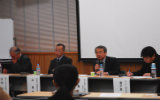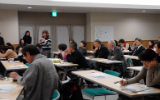WKC Forum report: Suicide Prevention and Community Support
WHO Centre for Health Development (WHO Kobe Centre - WKC) organized a forum on “Suicide Prevention and Community Support” in Kobe, 19 December 2013. More than 40 participants came to the WKC forum from the general public, local governments and health workers to learn the current trends of suicide cases and deepen their knowledge on prevention and response efforts locally and globally.

Dr Yutaro Setoya, Technical Officer of the Department of Mental Health and Substance Abuse (MSD), WHO HQ, reported about global trends and strategies for suicide prevention and presented on the WHO mhGAP Guideline. As concerns over the suicide prevention have grown globally, Member States agreed on a target of 10% reduction of the suicide rate in countries by the year 2020 at the 66th World Health Assembly in 2013. Dr Setoya announced that WHO will issue a first World Suicide Report in 2014. As Japan is advanced on the suicide prevention policy, further contribution from Japan to the global efforts for suicide prevention is expected, Dr Setoya said.
Dr Tadashi Takeshima, Director of the Centre for Suicide Prevention, Department of Mental Health Policy and Evaluation, National Institute of Mental Health, presented Japan’s fundamental policy on the comprehensive suicide prevention programme and emphasized that the key to reduce suicide is how the society as a whole can help people with suicidal thoughts to remove self-stigma. Statistically in Japan, suicide rates among the elderly have reduced while the rate among the youth has increased in recent years. Also, those who have attempted suicide and/or have harmed oneself are at the most risk of actually committing suicide, Dr Takeshima said. He also stressed that suicide prevention is a process to support them to retrieve their own freedom and the community as a whole need to support that process.

Mr Yasuo Hayashi, Director of the Suicide Prevention Section, Welfare Service for Persons with Disabilities Bureau, Health and Welfare Department of Hyogo Prefecture, presented the Hyogo Prefecture’s programme on suicide prevention. In Hyogo, suicide rates among people in their 20s and 40s haveincreased while the rates among people in their 50s and over 60 years old have decreased in recent years. From the local government perspective, Mr Hayashi presented Hyogo’s challenges to create “the society which no one will not be pushed to commit suicide”, such as implementing age-disaggregated projects for suicide prevention, strengthening the community system of watching over and early detection, and supports and cares for the bereaved.
As a representative of community support groups who provide free telephone counselling services, Mr Shigeaki Masaoka, Secretary General of Kobe Inochino Denwa, reported about their activities, suicide prevention efforts in Kobe City and their difficulty as a charity organization to balance their public relations activities for fundraising while protecting absolute privacy of consulters. Mr Masaoka reported that the number of telephone calls which Inochino Denwa receives annually is broadly flat since 2010, but more consulters hint their desire to commit suicide and/or confess their previous suicidal attempts during telephone counselling. He also expressed his deep concerns on the shortage of capable voluntary counsellors and the difficulty of their capacity building.

At the panel discussion and Q&A session, there were active discussions with the floor on actual suicide prevention and response projects on the ground, such as “Kobe G-P Net “(the comprehensive medical system to connect patients between Psychiatrists and General practitioners as team). Through discussions, it was shared among participants that there is still the need to deepen our understanding on suicide as a fact of attempting to kill oneself, to acknowledge repeating suicidal attempts as the highest risk factor of suicide, and to create more closer network among various actors at all levels in the society as a whole so as to reduce numbers of suicide cases.
Related links
- Presentation "Global Trends and Strategies for Suicide Prevention: WHO mhGAP Guideline" (Japanese)
Dr Yutaro Setoya, Technical Officer, Department of Mental Health and Substance Abuse (MSD), WHO HQ - Presentation "Suicide Prevention and Community Support" (Japanese)
Dr Tadashi Takeshima, Director, Centre for Suicide Prevention, Department of Mental Health Policy and Evaluation, National Institute of Mental Health - Presentation " Hyogo Prefecture's Suicide Prevention Programme" (Japanese)
Mr Yasuo Hayashi, Director, Suicide Prevention Section, Welfare Service for Persons with Disabilities Bureau, Health and Welfare Department of Hyogo Prefecture - Presentation "Activities of Inochino Denwa" (Japanese)
Mr Shigeaki Masaoka, Secretary General, Kobe Inochino Denwa

